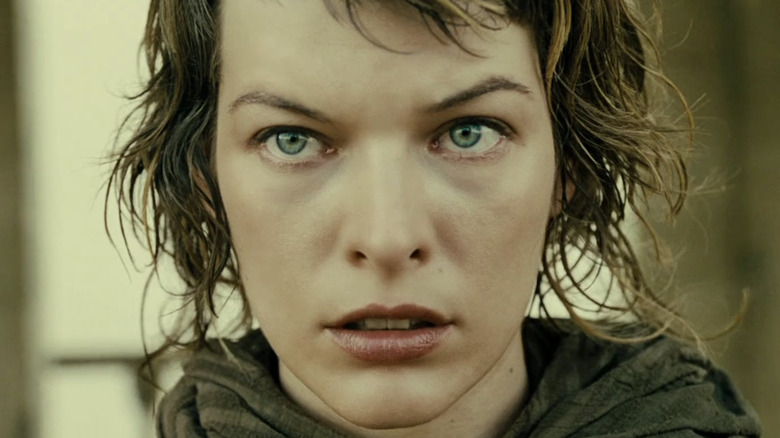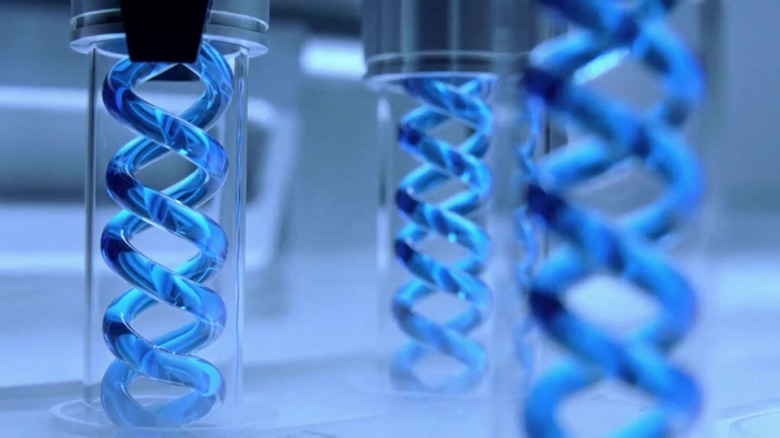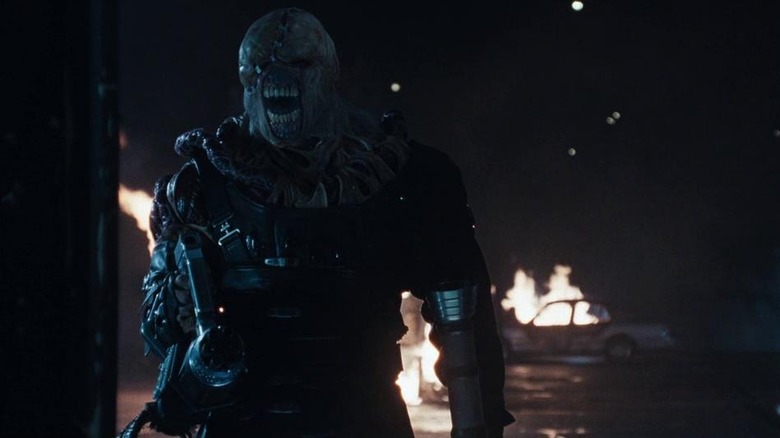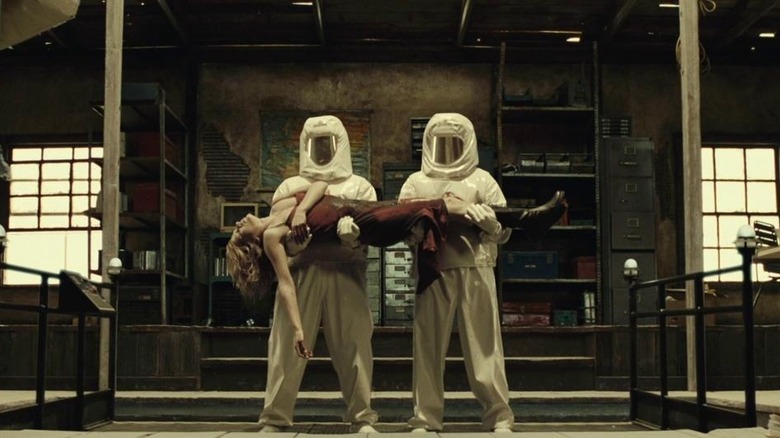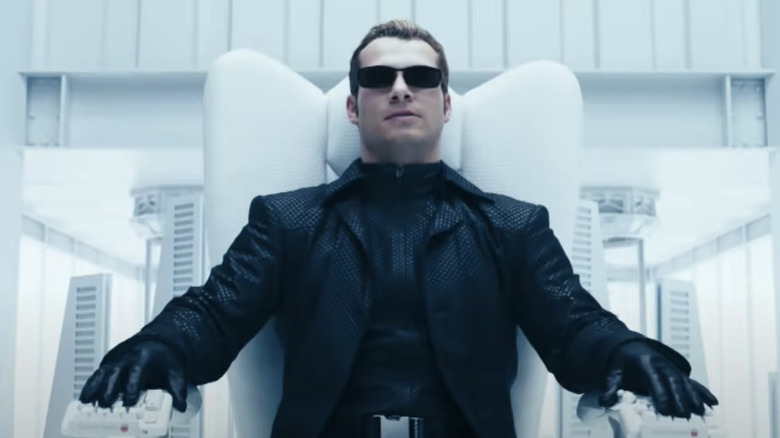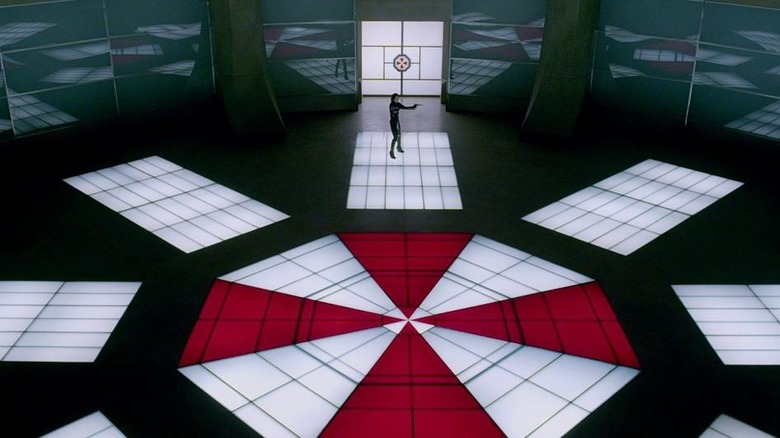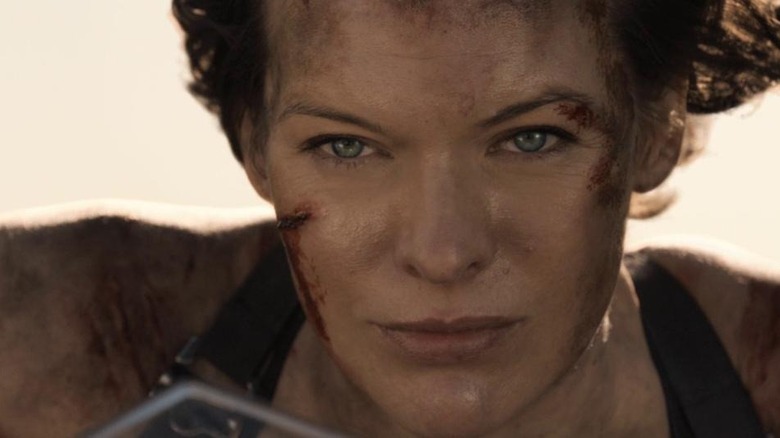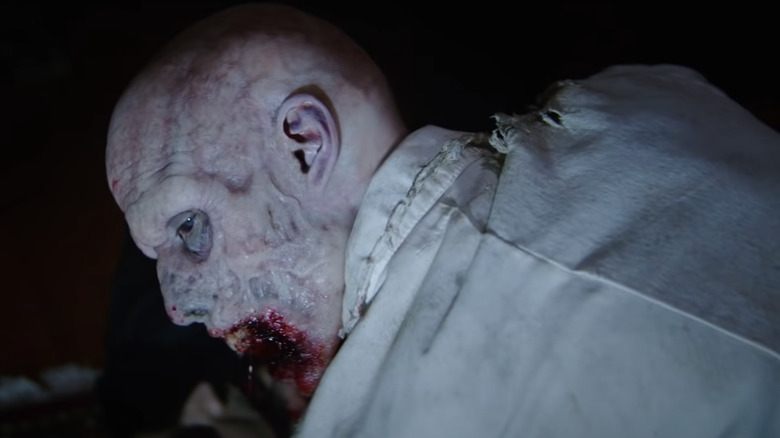How To Start Watching The Resident Evil Franchise
"Resident Evil" is a franchise that roots back to 1996 when the first video game in the nearly 30-game franchise first debuted. Following Chris Redfield, Jill Valentine, and secret antagonist, Albert Wesker–along with the rest of the S.T.A.R.S.–team to investigate a mansion overrun with zombies, the original game was relatively simple but gave birth to one of the most successful horror franchises of all time.
The original game created a blueprint for zombie and survival horror games alike. Naturally, as many popular games inevitably do, a movie franchise soon followed in 2002. Starring Milla Jovovich as the non-game-canon Alice and directed by Paul W. S. Anderson, the film opened to mixed reviews. Although the inspiration for "Resident Evil" the movie came from the video game franchise, fans of the games noted that the films weren't anything like what they were expecting.
Despite opening to mixed reviews and expectations, it inspired a six-film series that ran from 2002 to 2016. The timeline for the movies is relatively straightforward, as they go in chronological order based on their release dates.
Resident Evil launched the movie franchise
In 2002, Paul W. S. Anderson gave the world his reimagining of the beloved game franchise in "Resident Evil," the first film installment. Although the movie didn't set out to replicate the game to the letter, the first film did have several significant callbacks to the first few games in the franchise, specifically "Resident Evil" and "Resident Evil 2."
The movie introduces Alice, a character created for the film franchise, as she wakes up with amnesia. As the beginning of any series ought to do, "Resident Evil" laid out the groundwork for the universe to build on. This is the first time audiences are exposed to the T-virus in the cinematic universe, a manmade virus that turns people into zombies. The effects of the T-virus are vast as some people infected with it react and mutate differently. The T-virus is what gives Alice her superhuman abilities.
For the course of the first film, though, things are kept relatively simple. Alice uncovers that she works for the Umbrella Corporation, the company that created the T-virus. She fights against the outbreak, attempting to contain it after the Hive's (Umbrella's lab within Raccoon City, the home of Umbrella) AI and the Red Queen failed to do so.
Resident Evil: Apocalypse is a direct sequel to Resident Evil
"Resident Evil: Apocalypse" had a new director take over. W. S. Anderson stayed as a producer, but the reigns were handed to Alexander Witt. The sequel might be one of the closest parallels fans saw to a plot line from the original games. While not the same, "Apocalypse" followed similar story beats to "Resident Evil 3."
In RE3, Jill Valentine is searching for an anti-virus that will cure the outbreak before a nuke can be dropped on Raccoon City. Desperate to keep her city from being destroyed, she spends most of the game attempting to deliver the cure. Unfortunately, her efforts are for nothing, as the game's ending sees the nuke destroy Raccoon City while she escapes in a helicopter.
"Apocalypse" is somewhat similar in that Alice is attempting to escape Raccoon City for the same reason of imminent destruction. Jill Valentine (Sienna Guillory) and Carlos Olivera (Oded Fehr), the two main and playable characters from RE3 are introduced in this film, as well as the main antagonist of the third game, Nemesis. Initially created to hunt down the remaining S.T.A.R.S. members, Nemesis plays a more general villain in the film. As a bioweapon developed by Umbrella, he is one of the most recognizable and iconically terrifying enemies in the franchise.
Resident Evil: Extinction is the third film in the series
Premiering in 2007, "Resident Evil: Extinction" is where the films take a massive turn away from the games. In the "Resident Evil" games, most of the outbreaks are contained relatively well. Yes, cities can be overrun, and the virus can spread, but it's never really been on a global scale. There are organizations set in place, like the BSAA, that exist specifically to combat these situations, and so far, an outbreak has failed to expand on a global scale. Often contained to a single location, like the Spencer Mansion from the first game or the Baker Family's home in RE7, the games take a different approach to the threats of these viruses.
"Resident Evil: Extinction" explores the reality of the T-virus spreading on a global scale. This film primarily focuses on Alice's attempts to get herself and other survivors to Alaska, where they hope they might be safe from the worldwide outbreak. It also introduces a plot line of Umbrella attempting to clone Alice to replicate her abilities.
Although this film has taken a very different approach to spreading the T-virus than the games ever did, it introduced a few more iconic game characters, like the beloved villain, Albert Wesker (Jason O'Mara). Claire Redfield (Ali Larter), the sister of Chris Redfield, also makes her debut here.
Resident Evil: Afterlife finally introduces Chris
As one of the prominent faces of the game series and the original protagonist alongside Jill Valentine, it's almost shameful that it took the series four movies to include Chris Redfield (Wentworth Miller), but "Resident Evil: Afterlife" finally included him. W. S. Anderson returned to direct "Afterlife" and would also finish the series.
Taking place a year after "Extinction," fans got to see Alice team up with her clones to go against Albert Wesker. This decision ultimately costs Alice the price of her powers, so fans were also treated to her hitting a new low. While Alice isn't perfect by any means, thanks to her abilities and perseverance, it became hard to imagine a scenario where she wouldn't at least come out the other side swinging. This is the first time that Alice is personally knocked down a peg because up until this point, even the zombie apocalypse doesn't seem to be a real threat to her.
Resident Evil: Retribution puts Albert Wesker front and center
"Resident Evil: Retribution" is a direct sequel to "Afterlife," and it might be one of the more off-the-wall scripts for a "Resident Evil" inspired film. While RE has always been about the science and technology behind the manmade viruses that turn people into zombies, tyrants, and superhumans, at its core, it's always been a zombie series with sophisticated lore. As a horror franchise that always lets the monstrous results of the viruses shine, revisiting the Red Queen, the AI from the first movie, as the main antagonist, seemed like an odd choice. Seeking to destroy all life on Earth with its control of Umbrella, it must be shut down.
This film featured a fun team-up between Alice and Albert Wesker. Seeing Wesker forced into a pseudo-good-guy role was a fun role reversal that no one expected, considering Wesker has always been a by-any-means-necessary villain.
"Retribution" also introduced game fan favorite Leon S. Kennedy (Johann Urb), one of the main protagonists of RE2, 4, and 6. It also introduced Ada Wong (Bingbing Li) and Barry Burton (Kevin Durand) from the games.
Resident Evil: The Final Chapter – it's all in the name
"Resident Evil: The Final Chapter" hit theaters in 2017, and as the title promised, it was the final installment of the movie series. This film returns to the basics by having Alice return to Racoon City to confront Umbrella (aka the Red Queen AI and Albert Wesker, who has swapped sides once again).
"Resident Evil: The Final Chapter" might be the most controversial film in the franchise because it didn't include most of the surviving cast from the previous films. Every surviving game canon character is completely removed from this movie, killed in a battle that took place off-screen before the film's start. This angered many fans who believed that it was not only disrespectful but it was also bad writing.
Despite all of the disappointment, the film explored more in-depth information on the T-virus and gave viewers a peak at the person pulling the strings the entire time.
Resident Evil: Welcome to Raccoon City & more
Although the series starring Jovovich as Alice ended with "Resident Evil: The Final Chapter," that wasn't the last film ever made. In 2021, fans got a new adaptation of the "Resident Evil: Welcome to Raccoon City game series." This film had no connections to the W. S. Anderson films and tried to be a more accurate recount of the games.
Meshing the events of "Resident Evil" and "Resident Evil 2," the film followed the games a little more closely. Fans of the game series will know that 1, 2, and 3 all take place right around the same period, so meshing these games' plots together made quite a lot of sense for the film. The adaptation wasn't a perfect replica. Most notably, the changes to Claire Redfield's personality and Albert Wesker's backstory stood out as the film's oddest choices. Still, even with its flaws, it was a much more accurate representation focused on the games' protagonists.
In addition to "Welcome to Raccoon City," there are several CGI movies in the franchise, most of which fit into the actual timeline of the games. In order the CGI films are: "Degeneration," "Damnation," Vendetta," and "Infinite Darkness."
